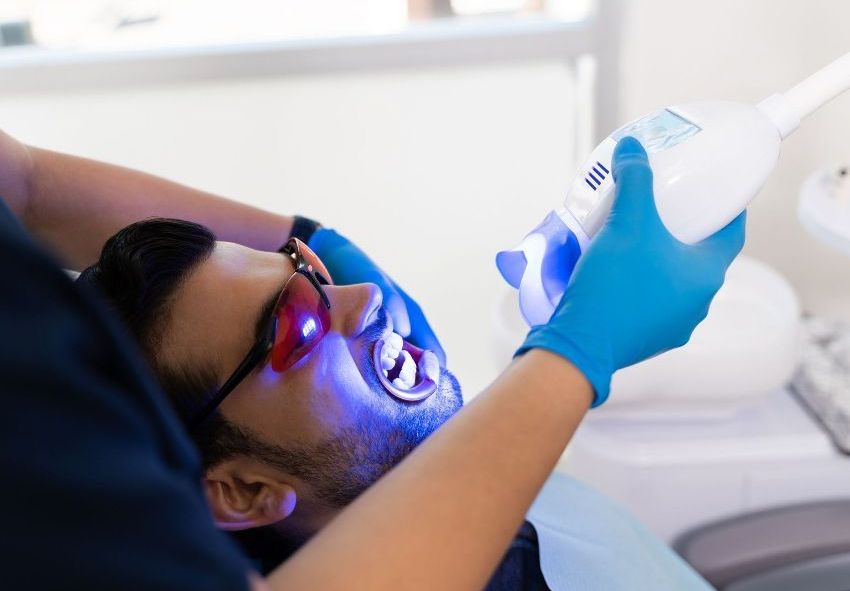Tooth Discoloration
Our experienced team at Dental Arts has created this informative page about tooth discoloration. Tooth discoloration affects both the appearance of a smile and its confidence. This page will help you to achieve a more vibrant, brighter smile by exploring the causes, types, and prevention of tooth discoloration.
What Causes Tooth Discoloration?
Extrinsic Factors
Tooth discoloration is often caused by external or extrinsic causes. These factors usually affect the enamel of the teeth. Extrinsic causes are:
Drinks and Foods
Certain foods and drinks with pigments that are strong can cause teeth to stain over time. Coffee, tea, tomato sauce, and dark-colored sodas are examples. Acidic drinks and foods can cause enamel erosion. This makes teeth more susceptible to staining.
Smoking and Other Tobacco Products
Smoking or using tobacco products can expose teeth to nicotine and tar, which can lead to yellow or brown stains. Tar in particular is notorious for adhering to enamel and causing discoloration.
Poor Oral Health
Lack of brushing and flossing and irregular dental cleanings may lead to the accumulation of plaque and tartar on teeth. Plaque accumulation is not only a cause of tooth decay and gum diseases, but it also causes surface discoloration and stains.
Environmental Factors
Tooth discoloration can be caused by exposure to environmental factors such as heavy metals or chemical compounds in water. Environmental pollutants or occupational hazards can also cause dental discoloration.
Intrinsic Factors
These factors affect the enamel, pulp, dentin, or dentin. These factors can cause varying levels of discoloration.
Aging
The enamel layer naturally thins out with age and reveals the dentin underneath. The dentin is yellower, causing a gradual change to the color of your teeth as you age.
Trauma to Teeth
A trauma to the tooth, such as a fracture, crack, or injury, can disrupt enamel and cause discoloration. Blood from damaged tissue can penetrate the dentin and cause a grayish appearance.
Medicines
Some medications, such as antibiotics like Tetracycline or Doxycycline, may cause tooth discoloration. This is especially true when taken during the tooth development phase in childhood. Some medications, including antihistamines and antipsychotics as well as chemotherapy drugs, can also cause tooth discoloration as a side effect.
Medical Conditions
Some medical conditions or treatments may affect tooth color. Discoloration can be caused by conditions such as enamel hypoplasia or dental fluorosis. Radiation therapy in the head and neck area can also cause tooth discoloration and changes in texture.
Dental Fluorosis
This can be caused by excessive fluoride exposure during tooth development. This could occur through the consumption of fluoridated water, topical fluoride applications, or supplements. Dental fluorosis is characterized by white or brown spots or streaks on the enamel surface.
Genetics
Genes can affect enamel thickness, tooth color, and mineralization. Some people inherit genes that can make teeth more susceptible to discoloration and enamel defects.
Combining Factors
Tooth discoloration can be caused by a combination of extrinsic factors and intrinsic ones. A person with genetic predispositions and a history of smoking, for example, may have a more severe discoloration if they consume staining food.
Different Types of Tooth Discoloration:
Surface Stains
Surface stains affect the enamel, the outermost layer of teeth. Surface stains are usually caused by external factors, such as drinking staining beverages and foods like red wine, coffee, tea, or soda. Surface stains can also be caused by habits such as smoking and using tobacco products. Surface stains can be removed by regular brushing or professional cleaning.
Enamel Discoloration
When the enamel changes color, it is called an enamel discoloration. This type of discoloration is caused by many factors including genetics and conditions that occur during tooth development. Discoloration of the teeth or white spots can be caused by enamel defects or hypoplasia. Cosmetic treatments like teeth whitening and dental bonding can improve the appearance of teeth with enamel discoloration.
Dentin Discoloration
The dentin layer is yellowish in color. Dentin discoloration is caused by the dentin becoming more visible because of changes to the enamel. This type of discoloration may be caused by aging, trauma, medications such as tetracycline, or an excessive intake of fluoride during tooth development. Dentin discoloration can appear in yellow, brown, or grayish shades and is difficult to treat with traditional whitening techniques.

Pulp Discoloration
Pulp discoloration is a change in the color of the pulp chamber. This chamber houses the nerves and blood vessels of the tooth. This type of discoloration is often caused by trauma, decay or infections of the pulp tissue. The pulp can become inflamed and infected causing discoloration that ranges from pink to black or dark brown. Root canal treatment may be required to restore the tooth color and address the underlying dental problem.

The Difference Between Intrinsic and Extrinsic Coloration
Tooth discoloration can be classified as either intrinsic or extrinsic. The enamel, dentin, or pulp are affected by intrinsic discoloration. Extrinsic stains, on the contrary, are visible on the surface of the teeth and are often caused by external factors such as diet, lifestyle, or exposure to the environment. It is important to distinguish between intrinsic and external discoloration in order to determine the best treatment and achieve optimal results.
Understanding the different types of discoloration can help determine the best treatment options and accurately diagnose the causes. Dental Arts of Catoosa specializes in cosmetic and restorative treatments that are tailored to different types of discoloration. We help our patients achieve a brighter, healthier smile. Consult Dr. Michaelsen today to explore your concerns and find personalized solutions for discoloration.
Prevention and Treatment
Consider the following tips to prevent discoloration of your teeth:
Keep up Good Oral Hygiene: Brush your teeth twice daily and floss regularly. Visit your dentist for professional cleanings.
Limit Staining Foods and Beverages: Reduce consumption of coffee, tea wine, sodas, and other foods and drinks that can cause teeth to become stained.
Stop Smoking and Chewing Tobacco: Smoking or chewing tobacco can cause severe tooth discoloration
Use Straws When Drinking Dark Liquids: Straws are useful when drinking beverages that stain teeth.
Regular Dental Checkups: Make sure to schedule routine dental check-ups for early detection and prevention of dental problems.

Treatment Options For Tooth Discoloration

There are several options available for treating tooth discoloration.
Professional teeth whitening: In-office whitening or at-home treatments that remove surface stains.
Dental bonding: Use of tooth-colored resins to cover minor discolorations, and improve the appearance of teeth.
Veneers: Veneers are thin porcelain shells that cover the front of the teeth to hide severe discolorations or imperfections.
Crowns: Customized crowns that restore the shape, function, and color of teeth severely damaged or discolored.
Contact Dental Arts
Contact Dental Arts if you are concerned about discoloration of your teeth or would like to learn more about treatment options. Contact Dr. Michaelsen for a consultation to determine your dental needs. You will be able to achieve a more confident, brighter smile.
